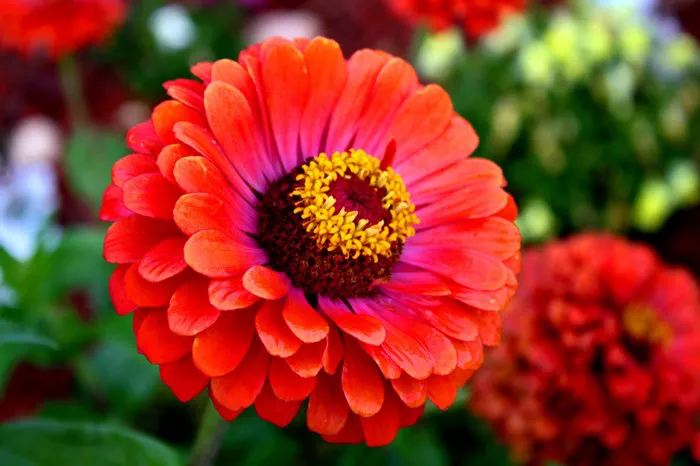Flowers have long been cherished not only for their beauty but also for the rich symbolism they carry. Among these floral messengers, the zinnia stands out with its vibrant hues and diverse varieties. From ancient cultures to modern gardens, the zinnia has captured hearts and minds, symbolizing a range of sentiments and virtues.
Origins and Cultural Significance
The zinnia, native to the Americas, particularly Mexico and the southwestern United States, holds deep cultural roots. It was named after the German botanist Johann Gottfried Zinn, yet its symbolism predates its European discovery. In Mexican folklore, the zinnia is often associated with thoughts of absent friends, symbolizing a wish for a friend to return. Its bright colors and endurance in the summer sun make it a symbol of endurance and lasting friendship.
In Native American cultures, the zinnia’s symbolism varies widely. Among the Pueblo tribes, it represents wisdom and endurance. In Hopi culture, the flower is associated with positivity and gratitude for the beauty of life.
See Also: What Does Dahlia Flower Symbolize?
Botanical Diversity
Zinnias belong to the Asteraceae family, which includes sunflowers and daisies. They are annual flowering plants known for their variety in size, color, and petal formation. Zinnia flowers can be as small as a few centimeters or as large as several inches in diameter. Their colors range from vibrant reds, oranges, and yellows to softer pinks, purples, and whites. Some varieties even exhibit multiple colors on a single flower.
The diversity of zinnia cultivars allows them to symbolize different aspects of human experience and emotion. For example, the bright red zinnia may symbolize passion and romance, while the white zinnia symbolizes purity and innocence.
Symbolism in Victorian Language of Flowers
During the Victorian era, flowers were often used to convey messages that could not be spoken aloud due to societal constraints. This “language of flowers” assigned specific meanings to different blooms, allowing people to communicate complex emotions through floral arrangements.
The zinnia found its place in this floral lexicon, symbolizing lasting affection and constancy. A bouquet of mixed-color zinnias could convey thoughts of friendship or the memory of an absent friend. Victorian gardeners appreciated the zinnia’s resilience and ability to thrive in various conditions, seeing it as a symbol of endurance and lasting friendship.
Cultural and Spiritual Significance
In addition to its role in folklore and the language of flowers, the zinnia holds spiritual significance in various cultures around the world. In Hinduism, flowers play a vital role in rituals and worship. Zinnias, with their bright colors and long-lasting blooms, are often used to adorn altars and offer prayers for prosperity and well-being.
In modern Western cultures, zinnias are often associated with qualities such as optimism, joy, and endurance. Their cheerful appearance and ability to thrive in challenging conditions make them a favorite among gardeners and florists alike.
Zinnias in Art and Literature
Throughout history, zinnias have inspired artists and writers with their vibrant colors and symbolic meanings. In art, zinnias have been depicted in paintings, sculptures, and other forms of visual expression. Famous painters such as Georgia O’Keeffe and Diego Rivera have incorporated zinnias into their work, capturing the flower’s beauty and symbolism.
In literature, zinnias have been used as symbols of beauty, resilience, and the passage of time. Writers often use flowers as metaphors to explore themes such as love, loss, and renewal. The zinnia’s bright colors and diverse forms make it a versatile symbol that can be adapted to various literary contexts.
Zinnias in Gardening and Landscaping
Zinnias are popular choices for gardens and landscaping due to their ease of cultivation and vibrant colors. They thrive in full sun and well-drained soil, making them ideal for summer gardens. Zinnias can be grown from seeds or transplanted as seedlings, allowing gardeners to enjoy their blooms throughout the growing season.
Gardeners often plant zinnias in borders, beds, and containers to add color and texture to outdoor spaces. Their long stems and large blooms make them excellent choices for cut flower arrangements and bouquets.
Zinnias as Symbols of Social Movements
In recent years, zinnias have become associated with social and political movements advocating for change and equality. The flower’s symbolism of endurance and resilience resonates with activists and advocates working to create a better world. Zinnias have been used in protest art, social media campaigns, and community gardens as symbols of hope and solidarity.
Conclusion
In conclusion, the zinnia flower embodies a rich tapestry of meanings that have evolved over centuries. From its origins in ancient cultures to its role in modern gardens and social movements, the zinnia continues to captivate and inspire. Its vibrant colors, diverse varieties, and enduring symbolism make it a beloved flower that holds a special place in the hearts of gardeners, artists, writers, and activists alike.
As we appreciate the beauty of zinnias in gardens and floral arrangements, let us also reflect on the deeper meanings they convey—of friendship, endurance, and the enduring beauty of nature itself. Whether used to express love, gratitude, or solidarity, the zinnia remains a powerful symbol that reminds us of the interconnectedness of life and the beauty that surrounds us.


